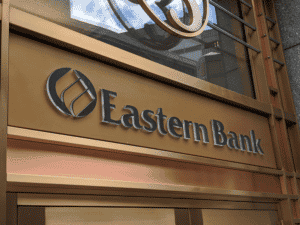Eastern Bank executives said their institution turned in a strong second quarter despite economic jitters that caused many companies nationwide to pause or shift investments.
The bank logged a $349 million increase in commercial lending last quarter, the bank’s earnings presentation Friday morning said. Just under $219 million of that was C&I lending across a “broad-based” range of industries, CFO David Rosato told Wall Street analysts, with the balance of the commercial growth coming from commercial real estate lending.
The Commerce Department’s monthly tally of non-defense capital goods orders, excluding aircraft, fell 0.7 percent in June, with economists estimating that business spending on equipment sharply slowed in the second quarter overall. Spending had surged to an annualized rate of 23.7 percent in the first quarter, which many observers said at the time suggested was a sign companies had accelerated planned purchases in an attempt to get ahead of President Donald Trump’s expected tariffs.
“While there still is some concern about economic volatility with tariffs and trade policy, et cetera, we’re seeing increasing confidence from our customer base and in the market broadly. That, of course, is subject to change depending on what comes out of Washington. But certainly, part of the impetus for this growth is we have been adding talent consistently over the past year in our commercial lending division,” CEO Denis Sheahan said in response to an analyst’s question. “The message that we’ve been delivering both to our commercial division and to our customers as we are open for business. We are ready to grow. We have the capital to grow. We have the expertise. And it’s beginning to bear fruit.”
In his prepared remarks, Rosato also credited the bank’s scale with letting it offer “a broad suite of products and services” that helped it win over commercial borrowers.
With regulatory and investor pressure to reduce their dependence on commercial real estate development and investment lending, non-real estate business lending has become a major area of competition among Massachusetts banks. In its own quarterly earnings call last week, Rockland Trust executives stated an ambition to seize C&I market share from competitors as they try to drive organic growth separate from mergers.
Eastern’s growing C&I pipeline meant its loan portfolio ended the quarter at $18.59 billion, while operating noninterest income came in at $42.2 million, up $8 million over the second quarter of 2024, while net interest income settled at $206.8 million, up from $133.2 million over the second quarter of 2024, shortly before it competed its purchase of Cambridge Trust. The bank’s net interest margin grew to 3.59 percent, up from 3.38 percent in the first quarter of this year.
The bank has only one criticized office loan maturing in the next four quarters, Rosato said, and that loan’s sponsor is currently continuing to make payments.
Eastern Bank’s pending, $490 million acquisition of Brockton-based HarborOne Bank still on track to close in the fourth quarter, Sheahan said. But when an analyst asked if the entry into the Providence, Rhode Island market the deal provides means the bank’s set its sights on further southward expansion, Sheahan was categorical.
“We certainly are welcoming the opportunity to engage in the Rhode Island market, and we will look to build out in that market both in terms of our commercial, our consumer businesses and our wealth management business. But we don’t have plans to extend into Connecticut from a banking perspective” on top of its existing wealth management operations there,” he said.
Another analyst asked whether the bank intended to look into any expansions in Maine in the “near or medium term,” Sheahan had a similar answer: “strategically, we’re not planning to expand into Maine.”







